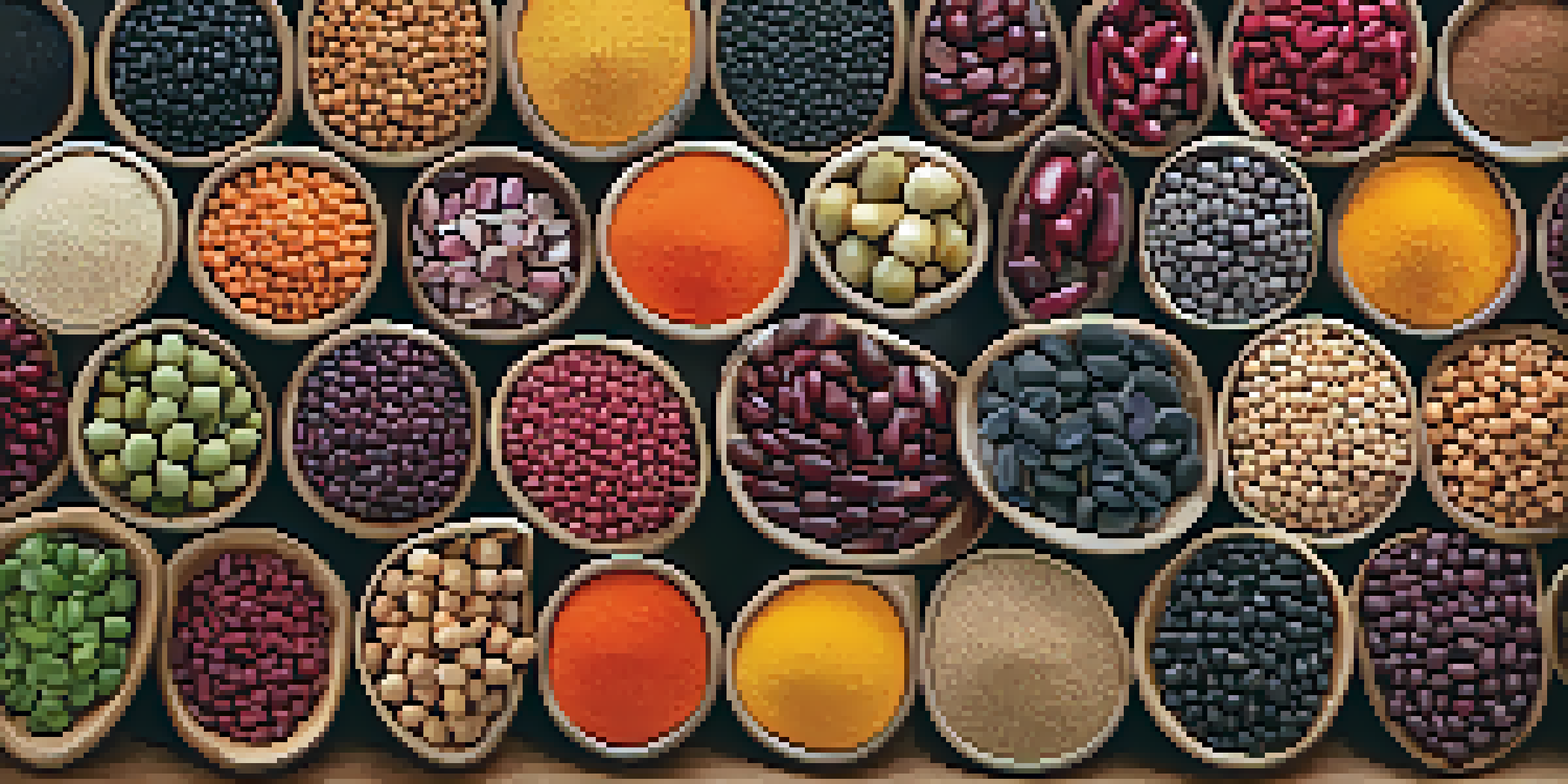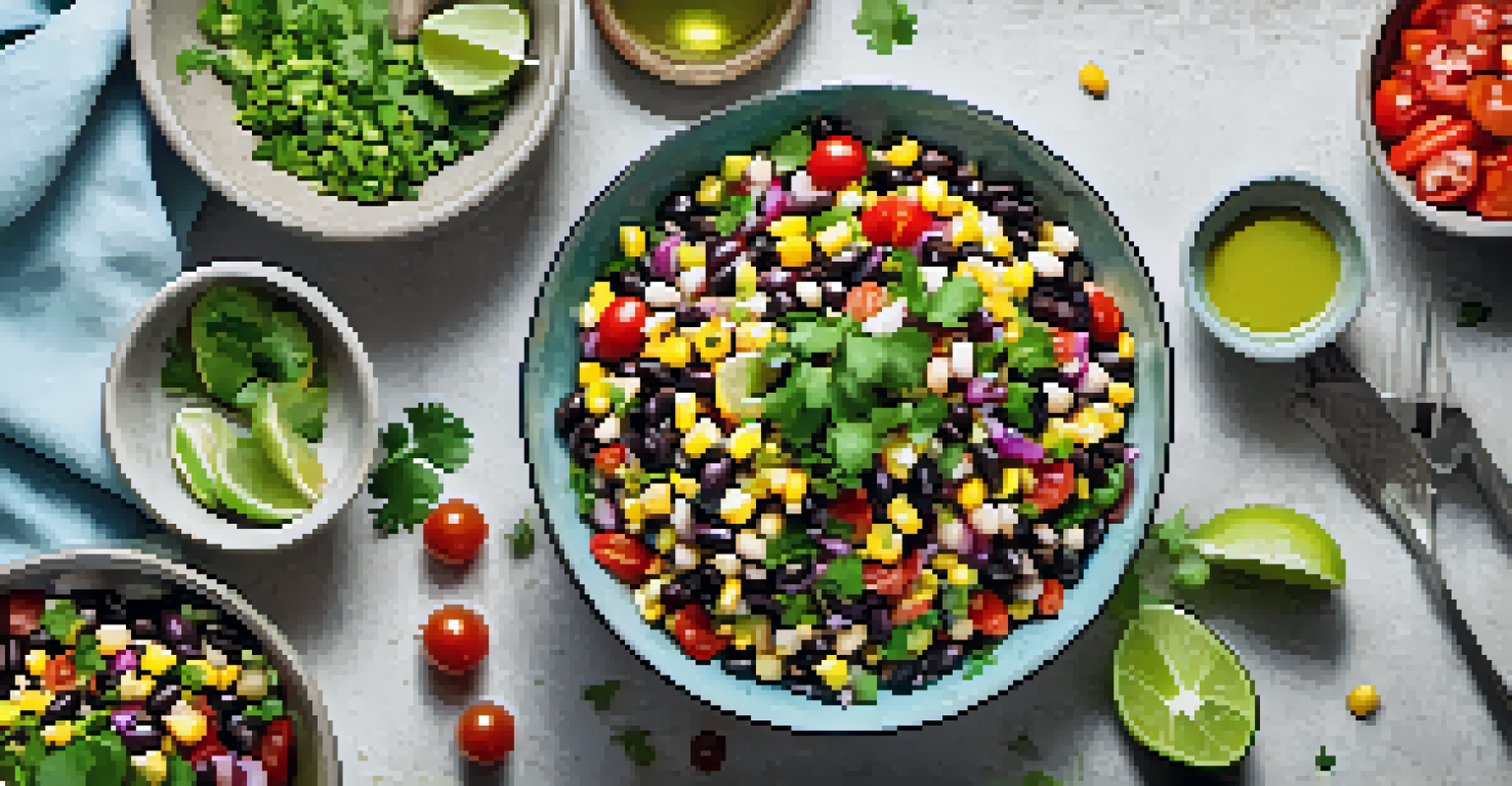The Ultimate Guide to Cooking Legumes for Vegetarian Meals

Why Legumes Are Essential in Vegetarian Cooking
Legumes are a powerhouse of nutrition, packed with protein, fiber, and essential vitamins. They serve as a fantastic meat substitute, making them a staple in vegetarian diets. With varieties like lentils, chickpeas, and black beans, the options are endless and versatile.
Legumes are the new superfood, providing the foundation for a sustainable and healthy diet.
Incorporating legumes into your meals can elevate the nutritional profile of your dishes. They not only help in building muscle but also keep you feeling full longer, which is especially beneficial for those aiming to maintain or lose weight. Plus, their rich flavors can transform a simple meal into something special.
Moreover, cooking with legumes is also budget-friendly. They are often less expensive than meat and can stretch your grocery budget, allowing you to create hearty meals without breaking the bank.
Different Types of Legumes and Their Uses
Legumes come in various forms, each with unique flavors and textures. For instance, lentils are quick to cook and perfect for soups and stews, while chickpeas can be roasted for a crunchy snack or blended into creamy hummus. Understanding the different types can help you choose the right one for your dish.

Kidney beans are great for chili, while black beans add depth to salads and burritos. Each type of legume can bring a distinct taste and nutritional benefit, enhancing the overall quality of your meals. Experimenting with a variety of legumes can keep your vegetarian cooking exciting and diverse.
Legumes Boost Nutrition in Meals
Packed with protein, fiber, and essential vitamins, legumes serve as a versatile and nutritious meat substitute in vegetarian cooking.
Don't forget about split peas or mung beans, which are excellent for making hearty dals or purees. With so many options, you'll never run out of ways to incorporate legumes into your diet.
How to Prepare Legumes: Soaking and Cooking
Proper preparation is key to ensuring that legumes are both tasty and easy to digest. Most dried legumes require soaking overnight to reduce cooking time and enhance their texture. However, lentils are an exception and can be cooked right away without soaking.
Food is not just what you eat, but how it nourishes your body and soul.
After soaking, rinse the legumes thoroughly and place them in a pot with fresh water. Generally, a good rule of thumb is to use three cups of water for every cup of dried legumes. Bring to a boil and then simmer until tender, which can take anywhere from 30 minutes to 2 hours, depending on the type.
Always check for doneness by tasting a few beans; they should be soft but not mushy. Adding spices or aromatics like garlic or bay leaves during cooking can elevate their flavor even more.
Tips for Flavoring and Seasoning Legumes
Legumes can be a blank canvas, ready to absorb flavors from various spices and seasonings. Start with a base of onions, garlic, or ginger sautéed in olive oil, which adds depth to your dishes. Experimenting with herbs and spices like cumin, paprika, or thyme can also bring out the best in your legumes.
Adding acid, such as lemon juice or vinegar, at the end of cooking can brighten the flavors and enhance the overall taste. Don’t be afraid to try different combinations; sometimes the most unexpected pairings can create a delightful dish.
Diverse Legumes Enhance Dishes
Understanding the unique flavors and textures of different legumes can elevate your meals and keep your cooking exciting.
Additionally, consider using broth instead of water for cooking legumes to infuse even more flavor. This simple tip can transform a basic dish into a delicious meal.
Quick and Easy Legume Recipes for Busy Weeknights
When time is of the essence, having quick and easy legume recipes on hand can save the day. One-pot meals like lentil soup or chickpea curry can be made in under 30 minutes, making them perfect for busy weeknights. Just toss in your ingredients, let them simmer, and you have a nutritious meal ready to go.
For a speedy dish, consider a bean salad with black beans, corn, and a zesty lime dressing. It's refreshing, filling, and requires minimal cooking. You can also make a simple stir-fry with cooked lentils, seasonal vegetables, and your favorite sauce.
These recipes not only save time but also ensure you’re getting the benefits of legumes without the hassle. With a bit of creativity, you can whip up delicious meals in no time.
Storing and Freezing Cooked Legumes
Proper storage of cooked legumes can help minimize waste and allow for quick meal prep later. Once cooked, let them cool completely before transferring to airtight containers. They can be stored in the refrigerator for up to a week, making it easy to grab a handful for salads or soups.
If you want to extend their shelf life, freezing is a great option. Portion out the cooked legumes into freezer-safe bags, removing as much air as possible to prevent freezer burn. They can last up to six months in the freezer, ready to be added to your favorite dishes.
Quick Recipes for Busy Nights
One-pot meals and quick salads featuring legumes can be prepared in under 30 minutes, making healthy eating accessible even on busy weeknights.
When you're ready to use frozen legumes, simply thaw them in the refrigerator overnight or add them directly to your cooking. This way, you always have legumes on hand for a quick and nutritious meal.
Exploring Global Legume Dishes for Inspiration
Legumes are a staple in many cultures around the world, providing a wealth of culinary inspiration. From Indian dal to Mediterranean falafel, the diversity of legume dishes is truly remarkable. Exploring these global recipes can introduce exciting flavors and techniques to your cooking.
For instance, try making a Moroccan chickpea stew with spices like cinnamon and cumin for a warm, comforting meal. Or whip up a classic Italian minestrone soup that highlights white beans and fresh vegetables, showcasing the versatility of legumes.

These international dishes not only offer delicious flavors but also highlight the nutritional benefits of legumes as a fundamental part of various cuisines. By incorporating them into your cooking, you can enjoy a world of taste while nourishing your body.